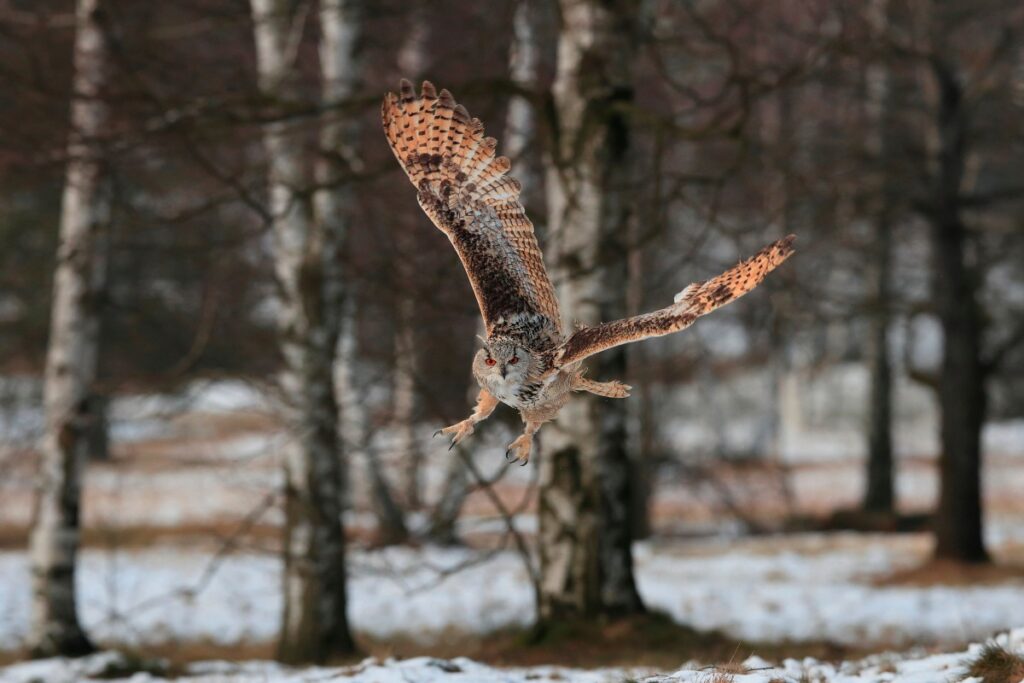Owls are raptors with sharp talons and beaks designed to grasp and rip open their prey. Most of the 200 species in the order Strigiformes hunt silently at night, with eyes well-suited to seeing in low light.
These birds occupy habitats worldwide except for the polar regions and isolated islands. The two families in this order, Strigidae and Tytonidae, contain species with highly variable life histories and longevities that depend on where they live and how large they can grow.
Generally, owls can live an average of 2 to 15 years in the wild, depending on the species. Owls kept in captivity may live longer than their species’ average, but many owls taken into captivity were rescued with injuries from situations that may ultimately decrease their lifespan.
Generally, large owls tend to have a higher average lifespan than small owls. Eurasian Eagle Owls are one of the largest owl species worldwide, with the greatest potential lifespan of all owls. Eurasian Pygmy Owls, the smallest owl in Europe, have the shortest lifespan.

How Long Do Owls in Captivity Live?
Owls are not a popular captive species, and in many countries, it is illegal to keep an owl as a pet unless the facility keeping it has a license. The United States government highly regulates owls kept in captivity, and the people that keep them must have training.
Captive owls cannot be domesticated and have the same hunting instincts as wild owls. People can see captive owls at zoos, wildlife refuges, and rehabilitation centers. Many rehabilitation centers rescue injured owls that will, hopefully, be released later.
Zoos typically keep owls captive for the entirety of their lives, feeding them a balanced diet with the proper nutrition that allows them to remain healthy and disease free, allowing them to live for more than 20 years, much longer than the average for most species.
Wildlife refuges often take rescued owls that cannot be released back into the wild and provide them with a safe home for the rest of their lives. Depending on the severity of their injury, the rescued owl’s lifespan may be shorter or longer than the average.
How Long Do Wild Owls Live?
Many owl species can live 15 years or longer in the wild if they have a consistent food source, avoid diseases, and escape predation and injury. These birds occupy the top of the food chain throughout their range and enjoy the benefits of longevity associated with that position.
Wild owls are most vulnerable as eggs and nestlings. In many owl species, around half of the nestlings die before fledging. Once owlets fledge and grow larger, their survival rate significantly increases.
What Kills Owls?
Most owls die from starvation or predation before they fledge. Owl nestlings are susceptible to predation from many predators, which varies depending on their habitat and location. These predators may include snakes, foxes, raccoons, cats, and other raptor species.
Few animals can prey on a full-grown owl except eagles, hawks, and other owls. Adult owls often die from injuries or avian diseases, like West Nile Virus. People who find injured or sick owls take them to rehabilitation centers where they can be treated.
One of the greatest threats to adult owls, particularly those that nest in suburban and urban areas, is collisions with motor vehicles. Owls hunt along the sides of roads, and motorists driving at night sometimes hit them as they swoop down to capture prey.
These collisions occur so frequently in some areas that scientists are conducting research to better understand why it happens and how to mitigate these events. Some owl populations are in decline because of the frequency of these collisions.
What is the Oldest Owl?
Some large owl species can live for many years in captivity. When they receive the best care and eat a healthy diet, they can survive much longer than owls in the wild. The oldest owl was a Eurasian Eagle Owl that lived more than 60 years in captivity.
While other long-lived captive owls have been recorded, they cannot compare to the longevity of Eurasian Eagle Owls. The oldest Barn Owl lived at the Ohio Wildlife Center for more than 26 years, and the oldest Great Horned Owl lived at the San Francisco Zoo for over 50 years.
Wild owls do not have the same long life span as captive owls because they must avoid starvation, disease, predation, and injury. Because of the dangers wild owls face, they live fewer years than the oldest captive owls.
The oldest wild Great Horned Owl lived for more than 28 years, the oldest wild Barn Owl in North America lived for more than 15 years, the oldest wild Barred Owl lived for more than 26 years, and the oldest wild Eastern Screech-Owl lived for more than 14 years.
